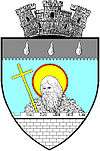Siret
| Siret | ||
|---|---|---|
| Town | ||
|
The statue of Margareta Muşat, downtown Siret | ||
| ||
 Siret Location of Siret | ||
| Coordinates: 47°57′11″N 26°4′21″E / 47.95306°N 26.07250°ECoordinates: 47°57′11″N 26°4′21″E / 47.95306°N 26.07250°E | ||
| Country |
| |
| County | Suceava County | |
| Status | Town | |
| Government | ||
| • Mayor | Adrian Popoiu (Social-Liberal Union) | |
| Area | ||
| • Total | 43.40 km2 (16.76 sq mi) | |
| Population (2011 census)[1] | ||
| • Total |
| |
| • Density | 178/km2 (460/sq mi) | |
| Time zone | EET (UTC+2) | |
| • Summer (DST) | EEST (UTC+3) | |
| Website | Official site | |
Siret (Romanian pronunciation: [siˈret]; German: Sereth; Polish: Seret; Hungarian: Szeretvásár) is a town in Suceava County, north-eastern Romania. It is situated in the historical region of Bukovina. Siret is the eleventh largest urban settlement in the county, with a population of 7,721 inhabitants, according to the 2011 census. It is one of the oldest towns in Romania and it was the capital of the former principality of Moldavia, in the late 14th century. The town administers two villages: Mănăstioara and Pădureni.
Geography
The town of Siret is located at the north-eastern limit of Suceava County, 2 kilometres (1 mile) from the border with Ukraine, being one of the main border passing points in the north of the country, having both a road border post and a rail connection.
The rail is on a standard gauge on the Romanian side and continues as a Russian-style broad gauge into Ukraine. Siret (actually the nearby border passing point called Vicşani - Vadul Siret) is one of the few places in Romania which provides a gauge change equipment, allowing transportation without transfer.
Siret is situated at the half distance between Chernivtsi and Suceava, on the right banks of Siret River. The European route E85 crosses the city.
History

During the period 1211–1225, on a hill near Siret a fortress was built by the Teutonic Knights. The town and the Teutonic castle were destroyed by the Tatars in 1241. The first document of Siret dates back to 1339, according to some historical sources. The town was the capital of the former principality of Moldavia, in the late 14th century.
The Russian Army occupied the town in 1770, and, as a consequence, an epidemic of cholera broke out. Together with the rest of Bukovina, Siret was under the rule of the Habsburg Monarchy (later Austria-Hungary) from 1775 to 1918.
During World War II, Siret was captured on 3 April 1944 by Soviet troops of the 1st Ukrainian Front in the course of the Dnieper–Carpathian Offensive.
At the beginning of the 20th century there was a prominent Jewish community, but most have now emigrated to Israel. Other denominations in the town are Romanian Orthodox, Greek Catholic, Roman Catholic and Protestant.
Demographics
| Historical population | ||
|---|---|---|
| Year | Pop. | ±% |
| 1910 | 7,948 | — |
| 1930 | 9,905 | +24.6% |
| 1948 | 8,058 | −18.6% |
| 1956 | 5,664 | −29.7% |
| 1966 | 8,018 | +41.6% |
| 1977 | 8,264 | +3.1% |
| 1992 | 10,071 | +21.9% |
| 2002 | 9,329 | −7.4% |
| 2011 | 7,721 | −17.2% |
| Source: Census data | ||
Siret reached its peak population in 1992, when more than 10,000 people were living within the town limits.
According to the 2011 census data, 7,721 inhabitants lived in Siret, a decrease from the figure recorded at the 2002 census, when the town had a population of 9,329 inhabitants. In 2011, of the total population, 95.85% were ethnic Romanians, 2.55% Ukrainians, 0.72% Poles, 0.42% Germans and 0.28% Russians and Lipovans.
Siret is the eleventh most populated urban locality in Suceava County.
Natives
- Yitzhak Artzi - Israeli politician
- Elisabeth Axmann - Romanian-German poet
- Elisabeta Lipă - Romanian rower
- Victorin Ursache - Romanian archbishop
International relations
Siret is a member of the Douzelage, a unique town twinning association of 24 towns across the European Union. This active program began in 1991, and regular events, such as a produce market from each of the other countries and festivals.[2][3] Discussions regarding membership are also in hand with three additional towns (Agros in Cyprus, Škofja Loka in Slovenia, and Tryavna in Bulgaria).
Twin towns – sister cities
Siret is twinned with:
Gallery
-
The Old Town Hall
-

Petru Muşat High School
-

The Chronic Diseases Hospital
-

The Old Train Station
-

Iacob Zadik House
-

Simion Florea Marian House
-

Simion Florea Marian Statue
-

Teodor V. Ştefanelli Statue
-

The Roman Catholic Church
-

The Greek Catholic Church
-

The Old Evangelical Church
-

The Jewish Temple
References
- ↑ "Suceava County at the 2011 census" (PDF) (in Romanian). INSSE. February 2, 2012. Retrieved March 12, 2012.
- ↑ "Douzelage.org: Home". www.douzelage.org. Retrieved October 21, 2009.
- ↑ "Douzelage.org: Member Towns". www.douzelage.org. Retrieved October 21, 2009.
- ↑ "Partnerstwo Samorządów Siłą Europy". Europa Miast (in Polish). Retrieved 2013-08-13.
External links
| Wikimedia Commons has media related to Siret. |
- (Romanian) Siret Town Hall official site
- (Romanian) Siret unofficial site
- (Romanian) Laţcu Vodă High School, Siret
- (Romanian) The Chronic Diseases Hospital of Siret
- (Romanian) Suceava County site - Siret web page
- (Romanian) Photo Gallery - Old photos of Siret
|


